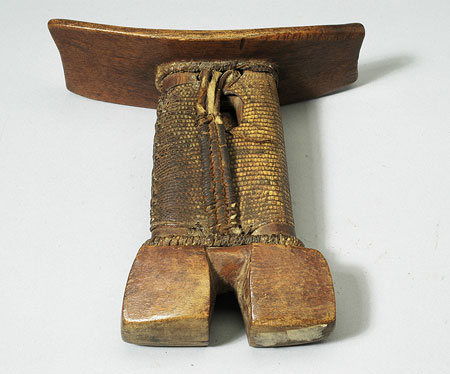Accession Number:
1936.10.95
Country:
Sudan
Region:
[Southern Sudan] Bahr el Jebel Terakeka
Cultural Group:
Bari
Date Made:
By 1936
Materials:
Wood Plant , Monitor Lizard Skin Reptile , Animal Hide Skin , Wool Yarn Animal? , Cotton Yarn Plant?
Process:
Carved , Stained , Polished , Covered , Stitched , Knotted Bound
Dimensions:
Ht = 227, seat L = 207, W = 93, th = 8, pedestal body W = 90, th = 34.4, opening L = 31; feet L (of pair) = 132.7, L (individually) = 54, W = 44, Ht foot = 54.5; handle L = 125, W = 18.6, th = 4.9 mm [RTS 11/4/2005].
Weight:
766.7 g
Other Owners:
This object was probably collected in 1935 or 1936, when Evans-Pritchard held a research fellowship from the Leverhulme Trust (see E.E. Evans-Pritchard, 1940, The Nuer) [RTS 23/8/2005].
Field Collector:
Edward Evan Evans-Pritchard
PRM Source:
Edward Evan Evans-Pritchard
Acquired:
Donated April 1936
Collected Date:
1935 - 1936
Description:
Wooden headrest or stool carved from a single piece of yellowish wood (Pantone 7508C), stained a reddish brown colour (Pantone 731C), and consisting of a narrow rectangular seat with slightly concave ends, one of which is narrower than the other.
The upper surface is convex across its width and concave along its length.
The seat has a flat underside with a pedestal foot extending from the centre; this has been carved into two oval sectioned columns joined by short cross bars at top and bottom, leaving a rectangular opening in the area between.
A series of holes have been bored through the solid part of the body above, and below these cross bars.
The body was then covered with a rectangular piece of yellow monitor lizard skin (Pantone 465C), with the joining edges sewn together using a narrow strip of the same material.
This was perforated along the centre of the top and base on each side, with similar thongs passing through these to the holes through the wooden body, to anchor the edges.
This covering creates a hollow compartment inside the body, that was accessed through an oval opening cut into the top of the skin piece on one side.
A narrow strip of hide was tied at top and base of the pedestal, bound round with a strip of reptile skin and used to anchor a carrying loop, which runs down over the front of this oval window.
This handle is made up of 3 strips of hide, with buff hair still in place on the surface (Pantone 7506C), with the lower two thirds of each strip bound in cord made of twisted cotton fibres or wool, now accreted with dark brown material.
Below the pedestal, a solid base has been carved in the form of 2 block-like feet with a rectangular section, joined by a solid bar across the top.
These feet have flattened undersides, but are still too curved to allow the object to stand on a flat surface unaided.
The object is complete and intact; the surface has been highly polished, but tool marks are still visible in areas, especially between the feet.
It has a weight of 766.7 grams, and is 227 mm high.
The seat is 207 mm long, 93 mm wide and 8 mm thick, and the pedestal body is 90 mm wide and 34.4 mm thick, with an opening that is 31 mm long.
The feet measure 132.7 mm across the pair, or around 54 mm long each, being 44 mm wide and 54.5 mm tall, while the carrying handle is 125 mm long, 18.6 wide and 4.9 mm thick.
Collected by Edward Evan Evans-Pritchard at Terakeka in 1935 or 1936, when Evans-Pritchard held a research fellowship from the Leverhulme Trust (see E.E. Evans-Pritchard, 1940, The Nuer). He does not give the local name for the type.
This object is extremely similar to another Bari headrest stool collected by Evans-Pritchard, 1936.10.94; other stools that incorporate similar internal body compartments include 1934.8.40 (Bari) and 1931.66.16 (Nuer).
Rachael Sparks 23/08/2005.
Collected by Edward Evan Evans-Pritchard at Terakeka in 1935 or 1936, when Evans-Pritchard held a research fellowship from the Leverhulme Trust (see E.E. Evans-Pritchard, 1940, The Nuer). He does not give the local name for the type.
This object is extremely similar to another Bari headrest stool collected by Evans-Pritchard, 1936.10.94; other stools that incorporate similar internal body compartments include 1934.8.40 (Bari) and 1931.66.16 (Nuer).
Rachael Sparks 23/08/2005.
Primary Documentation:
Accession Book Entry
[p.
410] - 1936 [insert] 10 [end insert] E.
EVANS-PRITCHARD, M.A., Exeter College, Oxford.
- Specimens collected by himself in the EASTERN SUDAN, while travelling with a Grant from the
Rockefeller
Leverhulme Trustees, viz: [p.
418] April [insert] 94-95 [end insert] - [One of] 2 wooden head-rest stools carved with two legs which are braced round with monitor-lizard skin, which forms a receptacle between the legs.
BARI, TERRA KEKA, UPPER NILE (West bank).
Card Catalogue Entry - There is no further information on the catalogue card [RTS 12/2/2004].
Pitt Rivers Museum label - AFRICA, Sudan, Terakeka. BARI. Wooden headrest stool with hollowed pedestal covered with monitor skin. d.d. E.E. Evans-Pritchard, 1936.10.95 [plastic coated label, tied to object; RTS 9/4/2005].
Written on object - Head-rest stool, BARI, TERRA KEKA, UPPER NILE (W. BANK). d.d. E. Evans-Pritchard, 1936 [black ink, RTS 9/4/2005].
Card Catalogue Entry - There is no further information on the catalogue card [RTS 12/2/2004].
Pitt Rivers Museum label - AFRICA, Sudan, Terakeka. BARI. Wooden headrest stool with hollowed pedestal covered with monitor skin. d.d. E.E. Evans-Pritchard, 1936.10.95 [plastic coated label, tied to object; RTS 9/4/2005].
Written on object - Head-rest stool, BARI, TERRA KEKA, UPPER NILE (W. BANK). d.d. E. Evans-Pritchard, 1936 [black ink, RTS 9/4/2005].





